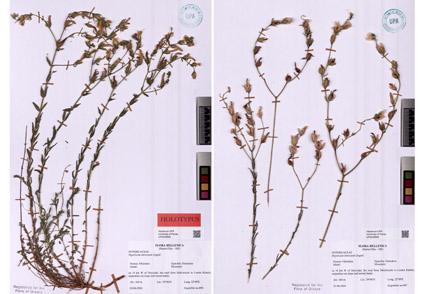Abstract
Hypericum intricatum, discovered in an ophiolitic area near the city of Domokos, Central Greece, is here described and illustrated as a species new to science. It belongs to section Olympia, as indicated by nuclear ribosomal ITS phylogeny, congruent with several but not all key morphological characters of this taxon. The sole known population of the new species is critically small and restricted to a floristically noteworthy spot accompanied by other rare and threatened serpentine-specialist species.
References
- Boissier, E. (1842) Plantae Aucherianae orientales enumeratae, cum novarum specierum descriptione. Annales des Sciences Naturelles; Botanique 2 (17): 150–205.
- Boissier, E. (1856) Diagnoses plantarum orientalium novarum, ser. 2, 5. B. Herrmann, Lipsiae [Leipzig], 118 pp.
- Carine, M.A. & Christenhusz, M.J.M. (2010) About this volume: the monograph of Hypericum by Norman Robson. Phytotaxa 4: 1–4. https://doi.org/10.11646/phytotaxa.4.1.1
- Cecchi, L., Španiel, S., Bianchi, E., Coppi, A., Gonnelli, C. & Selvi, F. (2020) Odontarrhena stridii (Brassicaceae), a new Nickel-hyperaccumulating species from mainland Greece. Plant Systematics and Evolution 306: 69. https://doi.org/10.1007/s00606-020-01687-3
- Degen, Á. (1891) Ergebnisse einer botanischen Reise nach der Insel Samothrake. Oesterreichische botanische Zeitschrift 41: 329–338. https://doi.org/10.1007/BF01798331
- Dimopoulos, P., Raus, Th., Bergmeier, E., Constantinidis, Th., Iatrou, G., Kokkini, S., Strid, A. & Tzanoudakis, D. (2013) Vascular plants of Greece: An annotated checklist. Botanischer Garten und Botanisches Museum Berlin-Dahlem, Berlin; Hellenic Botanical Society, Athens, 372 pp.
- Edgar, R.C. (2004) MUSCLE: multiple sequence alignment with high accuracy and high throughput. Nucleic Acids Research 32 (5): 1792–1797. https://doi.org/10.1093/nar/gkh340
- Hartvig, P. (1989) Polygonum papillosum (Polygonaceae), a new species from Central Greece. Willdenowia 19 (1): 75–78.
- Healey, A., Furtado, A., Cooper, T. & Henry, R.J. (2014) Protocol: A simple method for extracting next-generation sequencing quality genomic DNA from recalcitrant plant species. Plant Methods 10: 21. https://doi.org/10.1186/1746-4811-10-21
- Inkscape Project (2020) Inkscape. Available from https://inkscape.org (accessed 25 September 2024)
- IUCN (2024) The IUCN Red List of Threatened Species. Version 2024-1. Available from: https://www.iucnredlist.org (accessed 7 August 2024)
- Linnaeus, C. (1753) Species Plantarum. L. Salvius, Holmia [Stockholm], 1200 pp.
- Meseguer, A.S., Aldasoro, J.J. & Sanmartín, I. (2013) Bayesian inference of phylogeny, morphology and range evolution reveals a complex evolutionary history in St. John’s wort (Hypericum). Molecular Phylogenetics and Evolution 67 (2): 379–403. https://doi.org/10.1016/j.ympev.2013.02.007
- Nyman, C.F. (1878) Conspectus Florae Europaeae. Typis officinae Bohlinianae, Örebro, 858 pp.
- Nürk, N.M., Madriñán, S., Carine, M.A., Chase, M.W. & Blattner, F.R. (2013) Molecular phylogenetics and morphological evolution of St. John’s wort (Hypericum; Hypericaceae). Molecular Phylogenetics and Evolution 66: 1–16. https://doi.org/10.1016/j.ympev.2012.08.022
- Pančić, J. (1856) Verzeichniss der in Serbien wildwachsenden Phanerogamen. Verhandlungen des Zoologisch-Botanischen Vereins in Wien 6: 475–598.
- Phitos, D., Constantinidis, Th. & Kamari, G. (Eds.) (2009) The Red Data Book of rare and threatened plants of Greece, Vol. 1. Hellenic Botanical Society, Patras, (in Greek) 414 pp.
- POWO (2024) Plants of the World Online. Facilitated by the Royal Botanic Gardens, Kew. Published on the Internet; https://powo.science.kew.org/ (accessed 5 August 2024)
- Rambaut, A. (2014) FigTree v1.4.2. Institute of Evolutionary Biology, University of Edinburgh, Edinburgh. [https://tree.bio.ed.ac.uk/software/figtree/]
- Rechinger, K.H. (1961) Die Flora von Euboea I. Botanische Jahrbücher für Systematik, Pflanzengeschichte und Pflanzengeographie 80 (3) 294–382.
- Rešetnik, I., Schneeweiss, G.M. & Liber, Z. (2014) Two new combinations in the genus Bornmuellera (Brassicaceae). Phytotaxa 159 (4): 298–300. https://doi.org/10.11646/phytotaxa.159.4.8
- Robson, N.K.B. (1967) Notes on Turkish species of Hypericum. Notes from the Royal Botanic Garden, Edinburgh. Edinburgh and Glasgow 27 (2): 185–204.
- Robson, N.K.B. (1977) Studies in the genus Hypericum L. (Guttiferae): 1. Infrageneric classification. Bulletin of the British Museum (Natural History) Botany 5: 291–355.
- Robson, N.K.B. (1981) Studies in the genus Hypericum L. (Guttiferae): 2. Characters of the genus. Bulletin of the British Museum (Natural History) Botany 8: 55–226.
- Robson, N.K.B. (2006) Studies in the genus Hypericum L. (Clusiaceae). 4 (3). Section 9. Hypericum sensu lato (part 3): subsection 1. Hypericum series 2. Senanensia, subsection 2. Erecta and section 9b. Graveolentia. Systematics and Biodiversity 4: 19–98. https://doi.org/10.1017/S1477200005001842
- Robson, N.K.B. (2010a) Studies in the genus Hypericum L. (Hypericaceae) 5 (2). Sections 17. Hirtella to 19. Coridium. Phytotaxa 4: 127–258. https://doi.org/10.11646/phytotaxa.4.1.3
- Robson, N.K.B. (2010b) Studies in the genus Hypericum L. (Hypericaceae) 5 (1). Sections 10. Olympia to 15/16. Crossophyllum. Phytotaxa 4: 5–126. https://doi.org/10.11646/phytotaxa.4.1.2
- Robson, N.K.B. (2012) Studies in the genus Hypericum L. (Hypericaceae) 9. Addenda, corrigenda, keys, lists and general discussion. Phytotaxa 72: 1–111. https://doi.org/10.11646/phytotaxa.72.1.1
- Spach, E. (1836) Conspectus monographiae Hypericacearum. Annales des Sciences Naturelles; Botanique 2 (5): 349–369.
- Stamatakis, A. (2014) RAxML version 8: a tool for phylogenetic analysis and post-analysis of large phylogenies. Bioinformatics (Oxford, England) 30: 1312–1313. https://doi.org/10.1093/bioinformatics/btu033
- Strid, A. (2024) Atlas of the Hellenic Flora II. Broken Hill, Nicosia, pp. 701–1405.
- Zografidis, A., Koutroumpa, K., Liveri, E. & Dimopoulos, P. (2023) Centaurea dolopica (Asteraceae, Cardueae), a new species of section Acrocentron from Greece. Phytotaxa 584 (3): 173–185. https://doi.org/10.11646/phytotaxa.584.3.4


